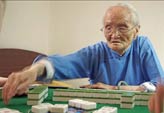IN BRIEF (Page 19)
Updated: 2011-09-07 07:42
(China Daily)
|
|||||||||
Fungus risk in hospitals is tackled
A fungus that has become a major threat to hospital patients may have a hidden weakness, according to research published on Monday that highlights the bug's ability to bind to human tissue.
Candida albicans is widespread among humans, but normally does not affect health other than as vaginal or oral yeast infections, also called thrush.
But in medical settings, C. albicans is a peril for sick people or individuals whose immune system has been compromised by cancer, HIV or organ transplant.
The latest research, published in a US journal on Monday, highlights a promising target: The mechanism that the yeast uses to latch on to human cells and colonize them, thanks to a tiny part of a protein call Als adhesin.
"Als adhesin proteins give the yeast an ability to thrive throughout the human body, which is what makes it such a dangerous infections," says Ernesto Cota, a medical biologist at Imperial College London.
The next step is to test experimental compounds on lab-dish samples of the fungus to see whether this will block the binding action.
'Brown fat' breakthrough may help obese
Australian scientists believe "brown fat", a wondrous tissue that burns energy to generate heat, could help people fight obesity, media reported on Monday.
A research team from Sydney's Garvan Institute of Medical Research (GIMR) has worked out how to grow brown fat from stem cells biopsied from adults, raising hopes that one day brown fat could be transplanted in obese people to speed up calories they burn, the Australian Associated Press (AAP) reported.
Garvan endocrinologist Paul Lee, who led the research, is optimistic about targeting brown fat as an obesity intervention, commenting, "It's a highly metabolically active form of fat, and very exciting that we may be able to stimulate its growth in people."
People are born with supplies of brown fat around their neckline to keep them warm as infants, according to scientists at GIMR.
Scientists now know that brown fat is present in most, if not all, adults mainly just behind the collarbone.
Studies have found that adults with brown fat are slimmer than those without.
"Although this is early work, it is a proof of concept study showing that the growth of brown fat cells is possible, using precursor cells taken from adult humans, under appropriate stimulation," Lee says.
Stem cell stroke trial looks hopeful
A pioneering clinical trial to inject stem cells into the brains of patients disabled by strokes has been cleared to progress to the next stage after the treatment raised no safety concerns in the first three candidates.
ReNeuron Group PLC , the British biotech behind the trial, says the independent Data Safety Monitoring Board had reviewed safety data from its ReN001 stem cell therapy and recommended the trial advance to the higher dose. "Data from the laboratory safety tests, neurological examinations and neurofunctional tests conducted thus far indicate that the ReN001 treatment is safe and well-tolerated at the initial dose," the company says in a statement.
The procedure involves injecting ReNeuron's neural stem cells into patients' brains in the hope they will repair areas damaged by stroke, thereby improving both mental and physical function.
ReNeuron's chief executive Michael Hunt says the clearance was an important milestone, and the preliminary data also backed up the group's other therapeutic programs using the CTX neural stem cell line that formed the basis of the ReN001 stroke treatment.
AFP-Reuters
(China Daily 09/07/2011 page19)











